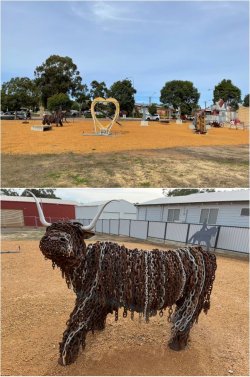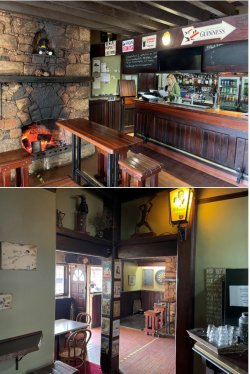- Joined
- Jun 7, 2006
- Posts
- 11,667
- Qantas
- LT Gold
My reader would recall that last week my mate dusted me off to help with some canola trial sowing near Boddington, about 1.5h drive SE of PER. Post #16505: The view from my "office"
It revealed a hidden gem that I hadn’t been to for quite a while. No time that day to do some exploring, but today, being PJM’s day off and PERfect weather, we went for a drive to scope the area.
I had planned to post a few pics on the View From My Office thread, but it got a bit too large for that.
To my mind, one of the things that is really interesting about Boddington is that it is the home of one of the country’s largest, if not the largest in terms of production, gold mines. Normally, at least in WA, we think of gold mines being in the outback a long way from capital cities, but this is in an agricultural and forested region close to the main city.
Additionally, it is home to the large Worsley bauxite mining operation that, unlike the Alcoa operation further west which processes near Perth and exports out of Kwinana, south of Fremantle, sends its ore SW to be refined near Collie and exported from Bunbury.
Both miners use conveyors to get the ore to their refineries, but Worsley takes it to another level. Their two mining centres, Marradong and Mt Saddleback are about 10km apart. A 10km conveyor takes the Marradong ore to the Mt Saddleback hub, where a 51km conveyor then moves all ore to the refinery. The claim is that this is the longest such conveyor in the world. It’s impressive.
From my perspective, as someone whose family came from the WA Goldfields, spent time in the rural southwest in my youth, and had a career in agriculture/biology research, it’s good to see agriculture and mining in the same area.
Here’s the area.

A bit closer. I am unsure about the origin of the two pits at the Newmont gold operation. The one to the south appears to be the currently active operation. Maybe the one to the north was the earlier, depleted orebody. It has been in operation since 1987 and has had one significant punctuation in its history (Boddington Gold Mine - Wikipedia).

Close-up of the bauxite mining. Note that agriculture surrounds the bauxite-rich areas, which are on quite significant non-arable hills where the forest was never cleared for agriculture. Following mining approval, all timber of commercial value is removed before clearing, then mining, followed by rehabilitation with returned stockpiled surface overburden. These techniques were developed since the Alcoa operations further west commenced in the 1960s.
The pits look pretty bleak at the time of mining, but later flourish.

Close-up of the gold mine. It’s certainly big.

It revealed a hidden gem that I hadn’t been to for quite a while. No time that day to do some exploring, but today, being PJM’s day off and PERfect weather, we went for a drive to scope the area.
I had planned to post a few pics on the View From My Office thread, but it got a bit too large for that.
To my mind, one of the things that is really interesting about Boddington is that it is the home of one of the country’s largest, if not the largest in terms of production, gold mines. Normally, at least in WA, we think of gold mines being in the outback a long way from capital cities, but this is in an agricultural and forested region close to the main city.
Additionally, it is home to the large Worsley bauxite mining operation that, unlike the Alcoa operation further west which processes near Perth and exports out of Kwinana, south of Fremantle, sends its ore SW to be refined near Collie and exported from Bunbury.
Both miners use conveyors to get the ore to their refineries, but Worsley takes it to another level. Their two mining centres, Marradong and Mt Saddleback are about 10km apart. A 10km conveyor takes the Marradong ore to the Mt Saddleback hub, where a 51km conveyor then moves all ore to the refinery. The claim is that this is the longest such conveyor in the world. It’s impressive.
From my perspective, as someone whose family came from the WA Goldfields, spent time in the rural southwest in my youth, and had a career in agriculture/biology research, it’s good to see agriculture and mining in the same area.
Here’s the area.

A bit closer. I am unsure about the origin of the two pits at the Newmont gold operation. The one to the south appears to be the currently active operation. Maybe the one to the north was the earlier, depleted orebody. It has been in operation since 1987 and has had one significant punctuation in its history (Boddington Gold Mine - Wikipedia).

Close-up of the bauxite mining. Note that agriculture surrounds the bauxite-rich areas, which are on quite significant non-arable hills where the forest was never cleared for agriculture. Following mining approval, all timber of commercial value is removed before clearing, then mining, followed by rehabilitation with returned stockpiled surface overburden. These techniques were developed since the Alcoa operations further west commenced in the 1960s.
The pits look pretty bleak at the time of mining, but later flourish.

Close-up of the gold mine. It’s certainly big.






































